Venturing into the vast expanse of the world’s oceans, one quickly realizes the incredible diversity and grandeur of marine life. Among the many wonders beneath the waves, some creatures stand out due to their immense size and majesty. The term “largest fish” might evoke images of the famed great white shark or perhaps the formidable tiger shark. Yet, the oceans hold even more giants, some of which are lesser-known but equally impressive. Here are the 10 largest fish in the world’s oceans.
List of the largest fish species in the world’s oceans
Fish size varies dramatically across different species, from the tiny dwarf goby, which measures less than an inch, to the colossal whale shark, the largest fish in the world. Here are the top 10 largest fish species in the world’s oceans by body length. You can also see the prehistoric giants’ sizes (including megalodon, the largest shark that ever lived, and Leedsichthys, the largest fish ever swam in the Earth’s oceans) at the bottom of this post.
10. Megamouth Shark: up to 5.49 meters [18 feet]
Megamouth shark (scientific name: Megachasma pelagios) is a species of deep-sea shark. It is the smallest of the three filter-feeding sharks (coming after the basking shark and the whale shark).
They can grow up to 5.49 meters (18 feet).
Megamouth sharks are rarely seen by humans. The species was first observed by scientists as late as 1976.
9. Tiger Shark: up to 5.5 meters [18 feet]
The tiger shark (scientific name: Galeocerdo cuvier) is the second-largest predatory shark, after the mighty great white. Females, which usually grow about 4 meters (13 feet), are bigger. An exceptionally large female caught off Australia reportedly measured 5.5 m (18 ft 1 in) long. It was also pregnant.
Larger (unconfirmed) catches of course have been claimed.
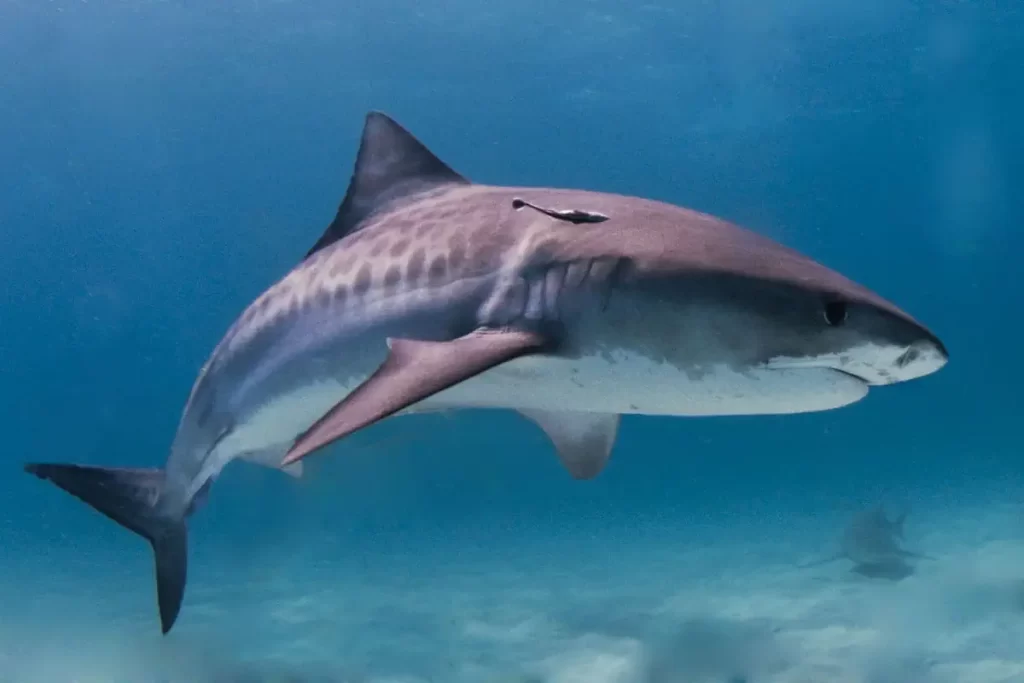
8. Kaluga (sturgeon): up to 5.6 meters [18 feet and 4 inches]
Kaluga (scientific name: Huso dauricus) is the second-largest freshwater fish, after Beluga. The largest specimen was recorded at 5.6 m (18.6 ft) in length and weighing over a ton.
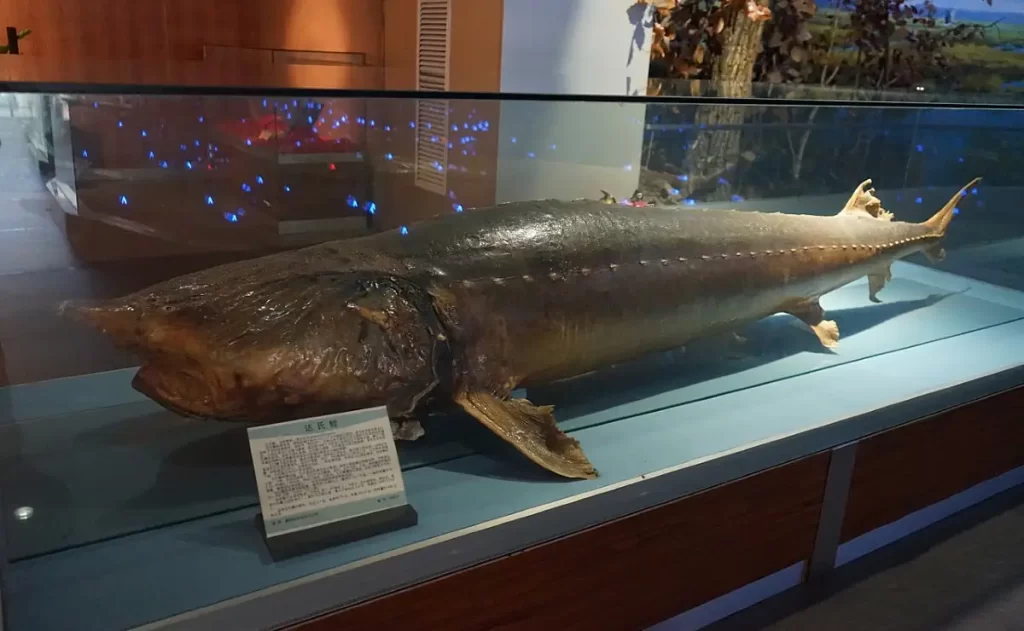
7. Great White Shark: up to 6.4 meters [21 feet]
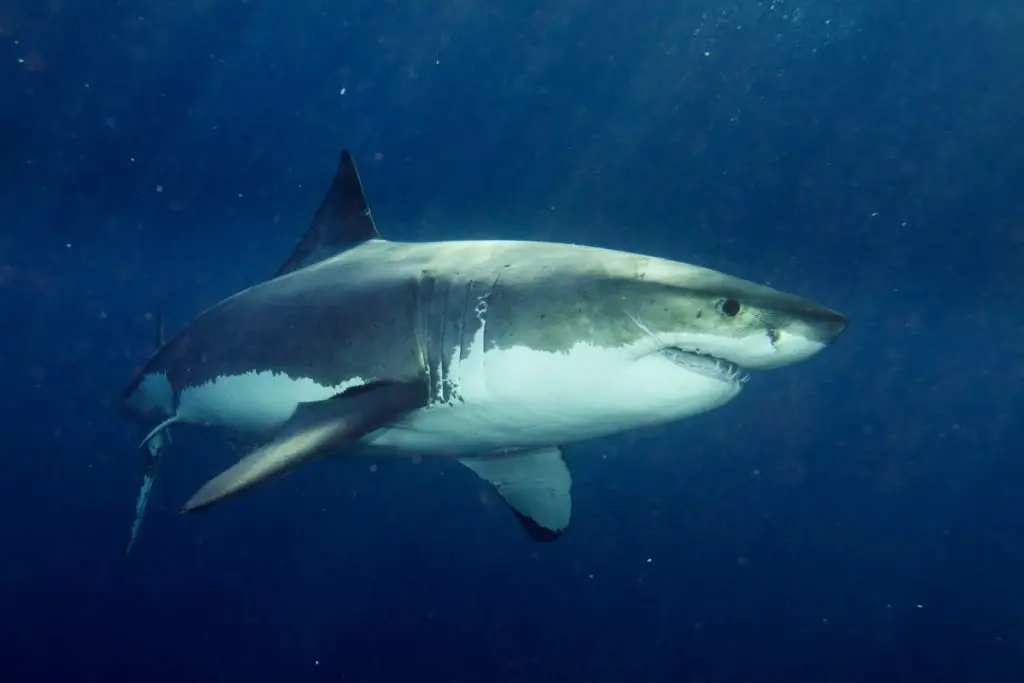
The great white shark (scientific name: Carcharodon carcharias) is the largest predatory fish on Earth. According to the Guinness World Records Book, full-grown adults are on average 4.3-4.6 meters (14-15 feet) in length and generally weigh 520-770 kg (1,150-1,700 lb). But they can grow up to 6.4 meters (21 feet), and there are many claims of huge specimens up to 10 m (33 ft) in length (most of these claims are unverifiable and probably false).
6. Pacific Sleeper Shark: Up to 7 meters [23 feet]

The Pacific sleeper shark (Somniosus pacificus) is a species of sleeper shark native to the North Pacific Ocean. They are dark grey to black in color and are not as well-known as other shark species due to their deep-sea habitat.
Mature sharks typically range from 12 to 14 feet (3.7 to 4.3 meters) in length, although some reports suggest they can reach lengths of up to 23 feet (7 meters).
For example, in 1989, an enormous Pacific sleeper shark was attracted to a bait in deep water outside Tokyo Bay, Japan, and filmed. The shark was estimated by Eugenie Clark to be about 7 meters (23 feet) long. Eugenie Clark (May 4, 1922 – February 25, 2015), popularly known as The Shark Lady, was an American ichthyologist (the branch of zoology devoted to the study of fish) known for her research on shark behavior.
A single unconfirmed account exists of an enormous Pacific sleeper shark that potentially measured more than 9.2 meters (30 feet) long. If true, this would make the species the largest extant macro-predatory shark, and the third largest shark overall after the whale shark and the basking shark.
These sharks prefer cold, deep waters, often at depths between 2,000 and 6,500 feet (600 to 2,000 meters), though they can also be found closer to the surface in colder regions.
Pacific sleeper sharks have a varied diet, consuming fish, cephalopods like octopuses and squids, and even marine mammals. Interestingly, the remains of giant squid have been found in the stomachs of some Pacific sleeper sharks, suggesting they might be one of the few predators of this elusive deep-sea creature.
As their name implies, they move slowly and are not as active as some other shark species. They are believed to be opportunistic feeders, relying on their keen sense of smell to locate prey.
Details of their reproductive habits remain somewhat elusive due to the deep-sea habitats they frequent. Like many sharks, they are believed to be ovoviviparous, where the young are hatched from eggs inside the mother’s body and then born live.
Pacific sleeper sharks are sometimes caught as bycatch by commercial fisheries. Their slow reproductive rate could make them vulnerable to overfishing, but they are not a primary target for fisheries, which somewhat reduces the threat.
Due to their deep-water habitats, interactions with humans are rare. However, they are sometimes caught by deep-sea fisheries, and in some areas, they’ve been known to approach underwater submersibles.
5. Beluga (sturgeon): up to 7.2 meters [23 feet and 8 inches]

The beluga or European sturgeon (Huso huso) is a large predator that feeds mostly on fish, and it also rarely consumes waterfowl and seal pups. It is a species of anadromous fish (the fish migrate from the sea up into freshwater to spawn; examples are salmon and striped bass – Greek: ἀνά ana, “up” and δρόμος dromos, “course”) in the sturgeon family (Acipenseridae) of order Acipenseriformes. It is found primarily in the Caspian and Black Sea basins, and occasionally in the Adriatic Sea.
The largest accepted record is of a female taken in 1827 in the Volga estuary at 1,571 kg (3,463 lb) and 7.2 m (23 feet 8 in, see notes 1). Several other records of aged sturgeon exceed 5 m (16 ft). These great sizes mark the beluga as the largest freshwater fish in the world.
4. Greenland Shark: up to 7.3 meters [24 feet]

Greenland Shark lives farther north than any other shark species. It is one of the largest living species of shark, with dimensions comparable to those of the great white shark. Greenland sharks grow to 6.4 m (21 ft) and 1,000 kg (2,200 lb), and possibly up to 7.3 meters (24 ft) and more than 1,400 kg (3,100 lb). However, most Greenland sharks observed have been around 2.44-4.8 meters (8.0-15.7 ft) long and weigh up to 400 kg (880 lb).
The Greenland shark has a sluggish look, with a thickset, cylindrical body, and a small head with a short snout and tiny eyes. Their maximum speed is a lethargic 1.7 miles per hour, many are almost blind, and they are happy to eat rotting carcasses: they particularly prefer the tastes of Narwhal and Beluga whale carcasses, and they sometimes participate in cannibalism. Furthermore, these sharks also enjoy seals, cetaceans, sea lions, salmon, lumpfish, halibut, char, capelin, herring, and other fish.
3. Giant Oarfish: up to 11 meters [36 feet]
The giant Oarfish is the longest bony fish on Earth. Although they commonly measure up to 3 meters (9.8 feet) in total length, they can grow a record length of 11 meters (36 feet). They are rarely seen because the Giant Oarfish live at depths around 3,300 feet (1,000 meters).

2. Basking Shark: up to 12.27 meters [40.3 feet]
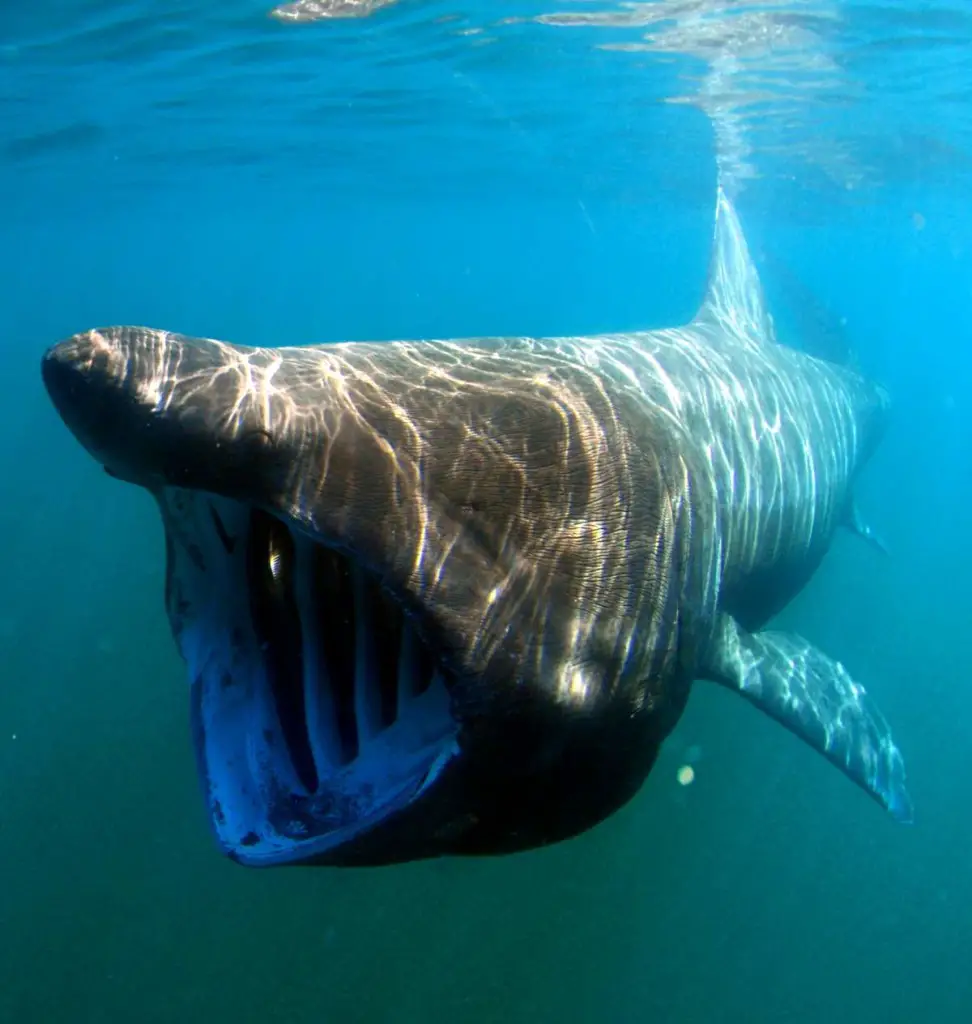
The basking shark (Cetorhinus maximus) is the second-largest living fish on Earth and one of three plankton-eating sharks besides the whale shark and megamouth shark. It can be found in all the world’s temperate oceans. It is a slow-moving filter feeder and has anatomical adaptations for filter feeding, such as a greatly enlarged mouth and highly developed gill rakers. Adults typically reach 8 meters (26 feet) in length.
The largest recorded specimen was found in the Bay of Fundy, Canada, in 1851. It was trapped in a herring net and was measured at a whopping 12.27 meters / 40.3 feet in length. It was about 16 tons in weight.
1. Whale Shark: up to 18.8 meters [61.7 feet] – the largest fish in the world
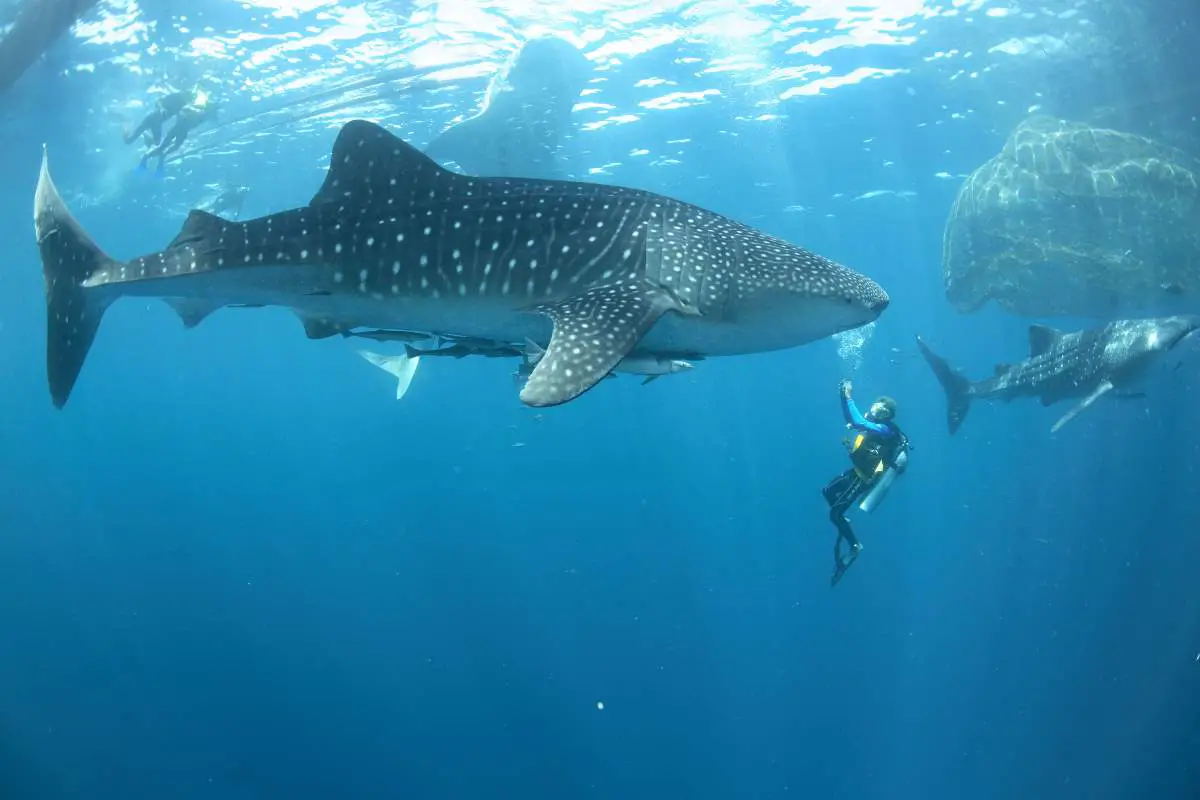
The whale shark (Rhincodon typus) is the largest known extant fish species. It is a slow-moving filter-feeding shark.
Reports of individuals over 14 m (46 ft) long and weighing at least 30 metric tons (66,000 lb) are not uncommon.
The largest confirmed individual had a length of 18.8 meters (61.7 feet). It was reported from the whale shark fishery off the coast of India in the Arabian Sea (Borrell et al., 2011).
Whale sharks have a mouth that can be 1.5 m (4.9 ft) wide, containing 300 to 350 rows of tiny teeth and 10 filter pads which it uses to filter feed.
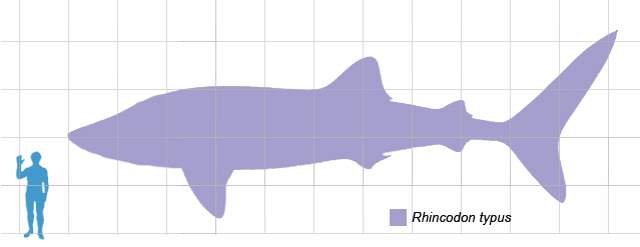
The video below was captured and submitted by GoPro Awards recipients shark biologist and freediver Ocean Ramsey and Juan Oliphant. They swim with whale sharks in the Philippines to document migrating populations. Whale shark populations are at an all-time low due to finning, fishing bycatch, entanglement, speedboat prop collisions, and death by ingestion of floating debris.
Join shark biologist and freediver Ocean Ramsey as she films with whale sharks in the Philippines to document migrating populations. Whale shark populations are at an all-time low due to finning, fishing

Related: Amazing Whale Shark Facts
Some other large fish species
There are some other living big fish species that can be included in this list. For example, the common thresher (Alopias vulpinus), can grow to 7.6 m (25 ft) and weigh over 510 kg (1,120 lb), but much of its length is comprised of its extreme tail, so I didn’t include it in the original list.

Another example is the Sawfish (Pristiformes): these little-known cartilaginous fishes are often reported to attain huge sizes. The definitive largest species is not known, although the smalltooth sawfish (Pristis pectinata) and the green sawfish (P. zijsron), at up to reportedly 7.6 and 7.3 meters (25 and 24 feet), respectively, maybe the largest.
Weights of up to 1,955 kg (4,310 lb) have been reported, possibly for the smalltooth species, but are not verified. The large-tooth sawfish (P. perotteti) and freshwater sawfish (P. microdon) can both exceed 6.5 meters (21 feet). Much of their length is comprised of their long “saw” noses.
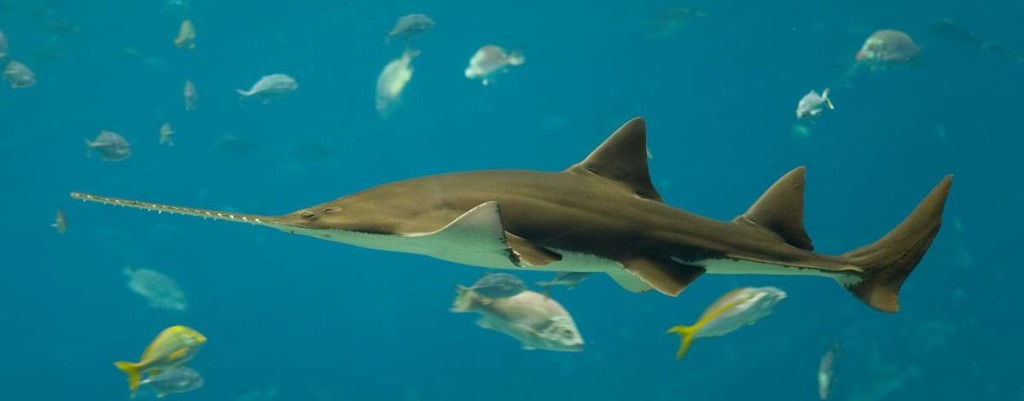
The heaviest living bony fish: Ocean sunfish

The ocean sunfish, or common mola, Mola mola is the heaviest of the bony fish in the world. The mature ocean sunfish has an average length of 1.8 meters (5.9 feet) and a fin-to-fin length of 2.5 meters (8.2 feet). The average weight of mature specimens can range from 247 to 1,000 kg (545 to 2,205 lb) Even larger individuals are not unheard of. The maximum size is up to 3.3 meters (10.8 feet) in length 4.2 meters (14 feet) across the fins and up to 2,300 kg (5,100 lb) in mass.
Update (July 24, 2017): Researchers Just Discovered A New Species Of the Ocean Sunfish
On July 20, 2017, National Geographic announced that researchers had discovered a new species of Ocean Sunfish. It has been named the Hoodwinker sunfish (Mola tecta) and is the first species of Ocean Sunfish to be identified in 130 years – somehow it has escaped taxonomy records for almost three centuries.
Prehistoric records – largest fish species ever lived
Megalodon – The largest shark ever lived on earth (up to 18 meters / 59 feet)
Megalodon (meaning “big tooth”, from Ancient Greek) is an extinct species of shark that lived approximately 15.9 to 2.6 million years ago, during the Cenozoic Era (middle Miocene to end of Pliocene). Fossil remains suggest that this giant shark reached a length of 18 meters (59 feet).
Megalodon had the most powerful bite of any creature that has ever lived: it is estimated that the bite force of a Megalodon’s jaws could generate somewhere in the vicinity of 108,514 N – 182,201 N (11-18 tons of force). For reference, this is about 6-10 times the biting power of a Great White Shark and 18-30 times that of a Lion. It is strong enough to crush an automobile and even far exceeded that of the Tyrannosaurus rex, which was capable of a maximum bite force of 35,000 to 57,000 newtons at its back teeth.
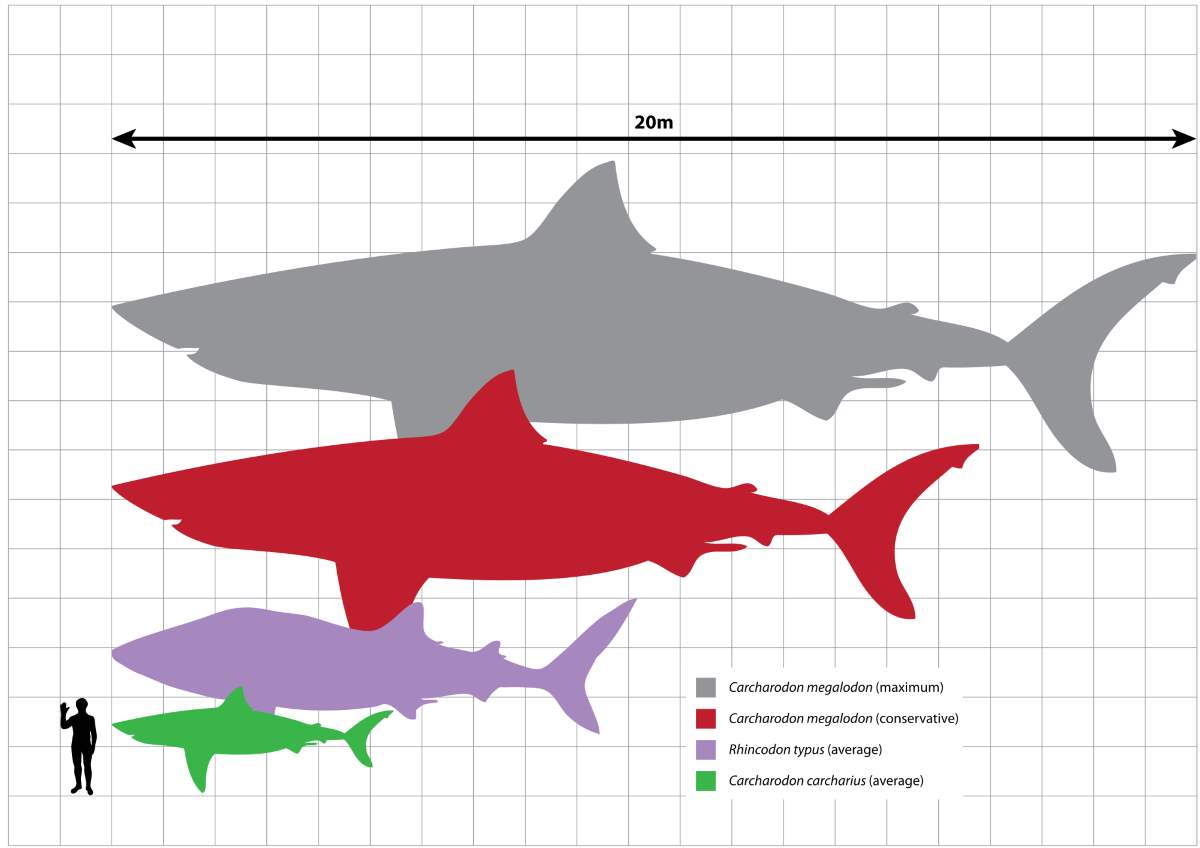

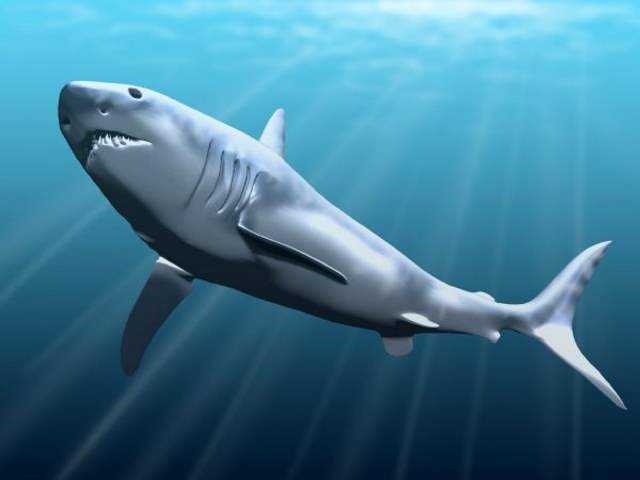
The largest known fish ever lived: Leedsichthys (22 meters / 72 feet)
The largest-ever known bony fish was Leedsichthys, of the Jurassic period in what is now England. Estimates of the size of this fish range from 21 to 27 meters (69 to 89 feet) and mass from 20 to 50 tons. A maximum size of 22 meters (72 feet) and 25-30 tons has been deemed to be the most realistic.
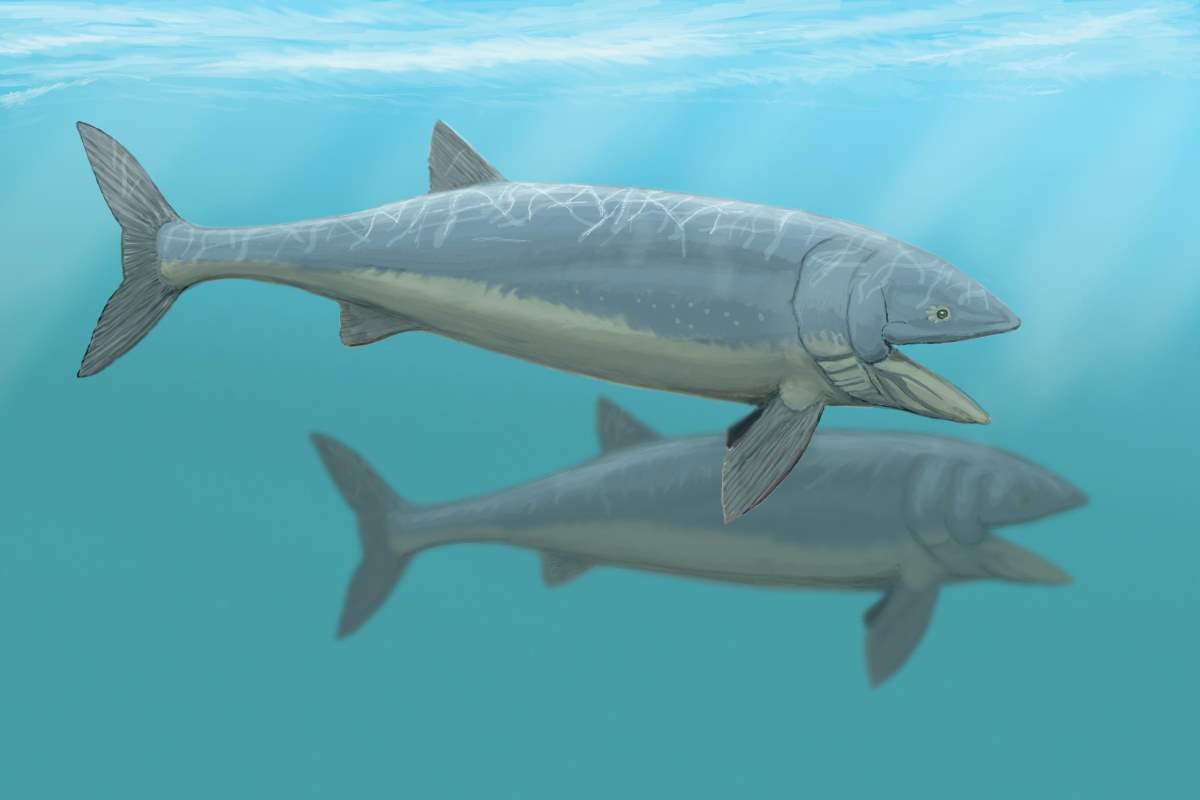
What is a fish?
At first, it looks like an easy question, but in fact, it is not. There is a wide range of animals we call “fish”, so it is not easy to define what makes a fish “a fish”. A general description: “A fish is any member of a paraphyletic group of organisms that consist of all gill-bearing aquatic craniate animals that lack limbs with digits”.
In general, all fishes have a brain protected by a braincase, and an obvious head region with eyes, teeth, and other sensory organs.
Most fishes:
- are vertebrates with vertebrae protecting the spinal cord.
- live in water.
- breathe primarily with gills rather than lungs.
- have paired limbs, in the form of fins that aid in locomotion.
- are unable to regulate their own internal body temperatures.
- are covered with scales that protect their bodies.
But there are exceptions: hagfish aren’t vertebrates and don’t have scales; mudskippers can live outside the water, lungfish use lungs to breathe, lampreys don’t have paired fins, and tuna are warm-blooded.
Fish can be found in nearly all aquatic environments, from high mountain streams (e.g., char and gudgeon) to the abyssal and even hadal depths of the deepest oceans (e.g., gulpers and anglerfish); in environments as hot as 104°F/40°C and as cold as 28°F/-2°C.
What Determines Fish Size?
The size of a fish is influenced by a range of factors, including its environment, diet, and evolutionary adaptations. In the vast expanses of the world’s oceans, fish size often correlates with the need for survival in specific ecological niches. Larger fish may dominate as apex predators, while smaller species often thrive in lower tiers of the food chain, relying on agility or camouflage for protection.
In marine environments, fish size can also be shaped by the availability of food and the need for efficient movement through water. For example, filter feeders like whale sharks grow to enormous sizes to maximize their ability to consume vast amounts of plankton and small marine organisms. Conversely, fish that inhabit coral reefs or areas with complex structures tend to be smaller, allowing them to navigate through narrow crevices and hide from predators. As a result, the size of a fish often reflects its role within its ecosystem, with each species evolving specific traits to help it thrive.
Additionally, fish size is a critical factor when considering conservation and fishing practices. Overfishing can have a profound impact on the size and population of large fish species, as many are slow to mature and reproduce. Protecting these large species, which often play essential roles in maintaining oceanic ecosystems, is crucial for preserving the balance of marine life. Fish size can thus serve as an indicator of the health of ocean ecosystems, and understanding the various factors that influence fish growth is vital for ensuring sustainable practices in marine environments.
Notes
- Wood, The Guinness Book of Animal Facts and Feats. Sterling Pub Co Inc. (1983).
Sources
- What is a fish? on Evolution.Berkeley.Edu
- Fish on Wikipedia
- Greenland shark on Wikipedia
- Beluga (sturgeon) on Wikipedia
- Basking shark on Wikipedia
- Whale shark on Wikipedia
- Smalltooth sawfish on Wikipedia
- List of largest fish on Wikipedia
- Megalodon on Wikipedia
- Leedsichthys on Wikipedia
- Ocean sunfish on Wikipedia
- Pacific sleeper shark on Wikipedia
- “Sizing ocean giants: patterns of intraspecific size variation in marine megafauna” on peerj.com
- “Rare Megamouth Shark Arrives at the Smithsonian” on the Smithsonian Magazine website
- How Many Elephants are Left in the World in 2025? - August 17, 2025
- Moon Landings: All-Time List [1966-2025] - February 2, 2025
- What Is Max-Q and Why Is It Important During Rocket Launches? - January 16, 2025
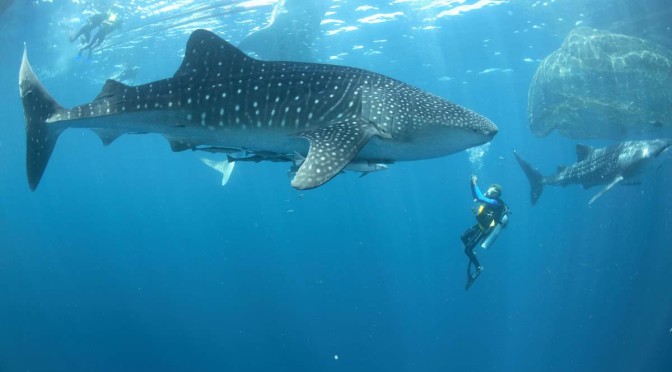

4 replies on “10 Largest Fish in the World’s Oceans”
Number 3 shuld be Greenland shark, not Great White Shark
Thanks for the correction!
I have a 8mm cine that I took of a whale shark that got caught in the south pier kuwait in 1958 when I worked there
Great! It must be a priceless experience. Did you publish the video on youtube or somewhere?